BBC National Programme

The BBC National Programme was a UK radio broadcasting service which was on the air from 9 March 1930 – when it replaced the earlier BBC radio station 5XX – until 1 September 1939, when it was subsumed into the BBC Home Service, two days before the outbreak of World War II.
Foundation
When the British Broadcasting Company (later to be nationalized as the British Broadcasting Corporation) began transmissions on 14 November 1922, the technology for both national coverage and joint programming between transmitters did not exist – transmitter powers were generally in the region of 1 kilowatt (kW).
From 9 July 1924, however, the company began experimenting with higher power longwave transmissions from the Marconi company's site near Chelmsford in Essex, using the call sign 5XX. The experiments proved successful and on 27 July 1925 the Chelmsford longwave transmitter was relocated to a more central site at Borough Hill near Daventry in Northamptonshire. This provided a "national service" of programmes originating in London, although it remained somewhat experimental and was supplementary to the BBC's locally based services, including its main London station, 2LO.
Initially the national programme was transmitted on 187.5 kHz longwave but this was later changed, with the opening in 1934 of a new high-power longwave transmitter site at Droitwich, to 200 kHz, which was to remain the BBC's longwave frequency until 1978, when it was moved slightly to 198 kHz. Mediumwave transmitters were used to augment coverage.
The Regional Scheme
On 21 August 1927, the BBC opened a high power mediumwave transmitter at the Daventry 5GB site, to replace the existing local stations in the English Midlands. That allowed the experimental longwave transmitter 5XX to provide a service programmed from London for the majority of the population. This came to be called the BBC National Programme.
By combining the resources of the local stations into one regional station in each area, with a basic sustaining service from London, the BBC hoped to increase programme quality whilst also centralising the management of the radio service. This was known as The Regional Scheme, and eventually resulted in the gradual extension throughout the 1930s of a separate BBC Regional Programme.
The local stations were gradually either converted to regional relays or closed entirely and replaced by high-power Regional Programme transmitters. Some local studios were retained to provide for programming from specific areas within each region. Most transmitters also carried the BBC National Programme on a local frequency to supplement the longwave broadcasts from 5XX, initially these were on three separate frequencies in order to minimise interference, but by 1939, as the Regional Programme network expanded, the National Programme's three remaining mediumwave transmitters – at Brookmans Park (for London and the South East), Moorside Edge (for The North), and Westerglen (for Central Scotland) – were all using 1149 kHz.[1]
Broadcasting Hours
The National Programme's broadcasting hours were from 10.15am until 12-Midnight Mondays to Saturdays, with Sundays commencing broadcasting at 3.00pm, however by the mid 1930s broadcasting on a Sunday was extended to commence at around 10.30am.
BBC News on the National Programme would not air until at least 6.00pm each day. This was in agreement with the newspapers, so to ensure people would buy a morning newspaper. The national programme did not have a dedicated news department until 1934, and only then was it used to edit and broadcast news material from other wire agencies in the country and around the world. The start of the second world war in September 1939 would see the start of a proper news service on the new BBC Home Service with morning news bulletins commencing at 7.00am each day.
Closure
Upon the outbreak of World War II, the BBC closed the Regional and National Programmes and replaced them with a single channel known as the BBC Home Service. The main transmitter network was synchronized between just two groups, using 668 and 767 kHz, each of which could be turned off during air raids to prevent its signals being used as navigational beacons (with listeners required to retune in such an event to a low-powered single-frequency network on 1474 kHz).
On 29 July 1945, within 12 weeks of VE Day, the BBC reactivated the Regional Programme, but retained the name "BBC Home Service". On the same date, the BBC Light Programme was launched, taking over the style and much of the function, as an entertainment channel, of the BBC Forces Programme (which had begun broadcasting in 1940), as well as the Droitwich 200 kHz longwave frequency which had been used by the pre-war National Programme.
Inheritance
Both the National Programme and the Regional Programme provided a mixed mainstream radio service. Whilst the two services provided different programming, allowing listeners a choice, they were not streamed to appeal to different audiences, rather, they were intended to offer a choice of programming to a single audience. While using the same transmitters, the National Programme broadcast significantly more speech and classical music than its successor, the Light Programme. Similarly, the Regional Programme broadcast much more light music than its successor, the Home Service.
References
- Various authors The BBC Year-book 1933 London: British Broadcasting Corporation 1932
- Various authors BBC Year Book 1947 London: British Broadcasting Corporation 1947
- Graham, Russ J A local service Radiomusications from Transdiffusion, undated; accessed 27 October 2015
- Graham, Russ J A new lease of life Radiomusications from Transdiffusion, undated; accessed 27 October 2015
- Groves, Paul History of radio transmission part 1: 1922 - 1967 Frequency Finder, undated; accessed 5 February 2006; updated 23 May 2010
- Paulu, Burton Radio and Television Broadcasting on the European Continent Minneapolis: University of Minnesota Press 1967
Further reading
- Briggs, Asa History of Broadcasting in the United Kingdom Oxford:Oxford University Press 1995 ISBN 0-19-212930-9
External links
- ↑ MDS975's Short UK radio history Archived 2011-06-11 at the Wayback Machine.